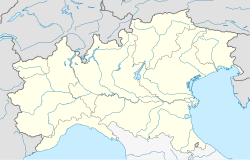Genova Brignole | |||||
|---|---|---|---|---|---|
 The 1905 station building | |||||
| General information | |||||
| Location | Piazza Verdi 16120 Genova Italy | ||||
| Coordinates | 44°24′24″N08°56′50″E / 44.40667°N 8.94722°E | ||||
| Owned by | Rete Ferroviaria Italiana | ||||
| Operated by | Centostazioni | ||||
| Line(s) | (Rome-) Pisa-Genoa Genoa-Milan Turin-Genoa Genoa-Ventimiglia (-France) | ||||
| Platforms | 9 pass + 2 freight | ||||
| Other information | |||||
| IATA code | GEP | ||||
| History | |||||
| Opened | 1868 | ||||
| Rebuilt | 1905 | ||||
| |||||
Genova Brignole railway station is the second largest station of Genoa, northern Italy; it is located on Piazza Verdi in the town center at the foot of the Montesano hill (the main long-distance station is Genova Piazza Principe station). Brignole is used by about 60,000 passengers a day and 22,000,000 per year. [1]




